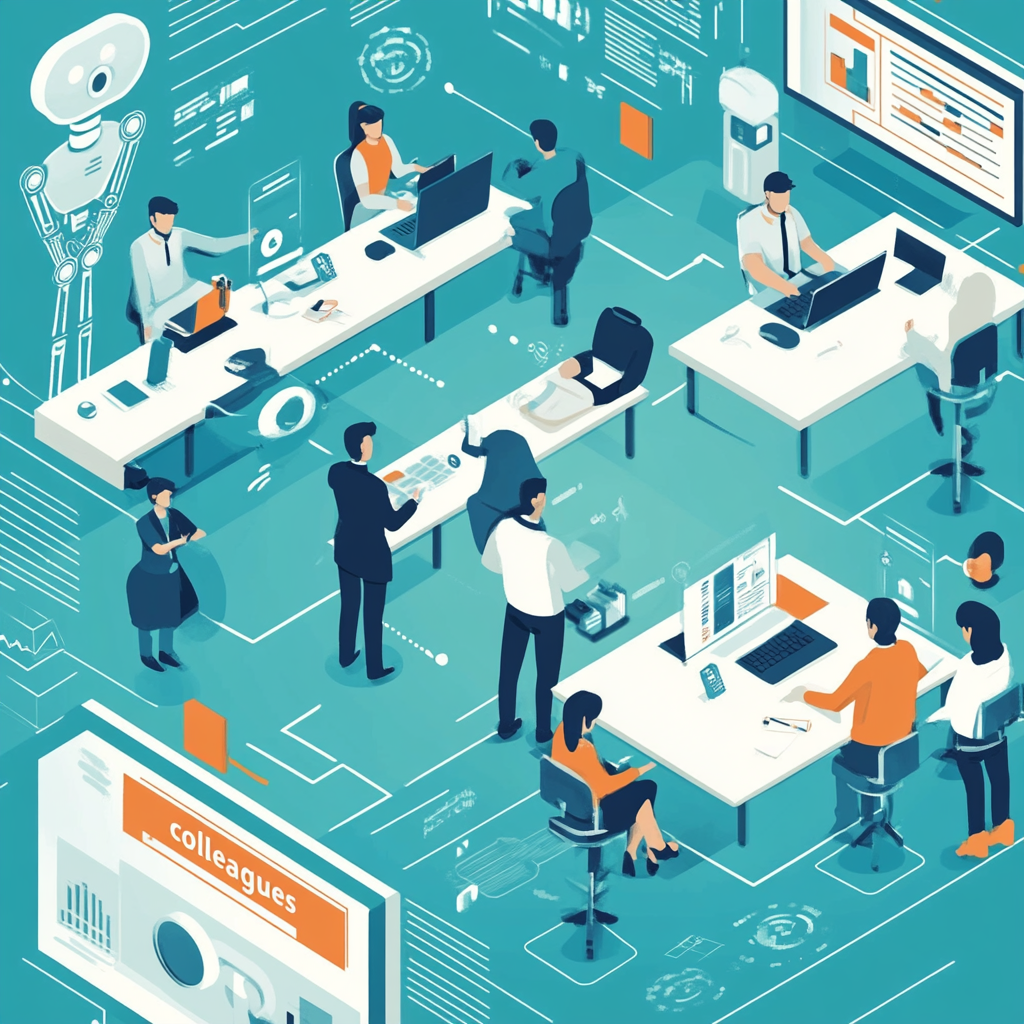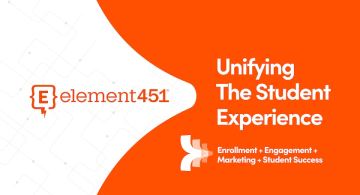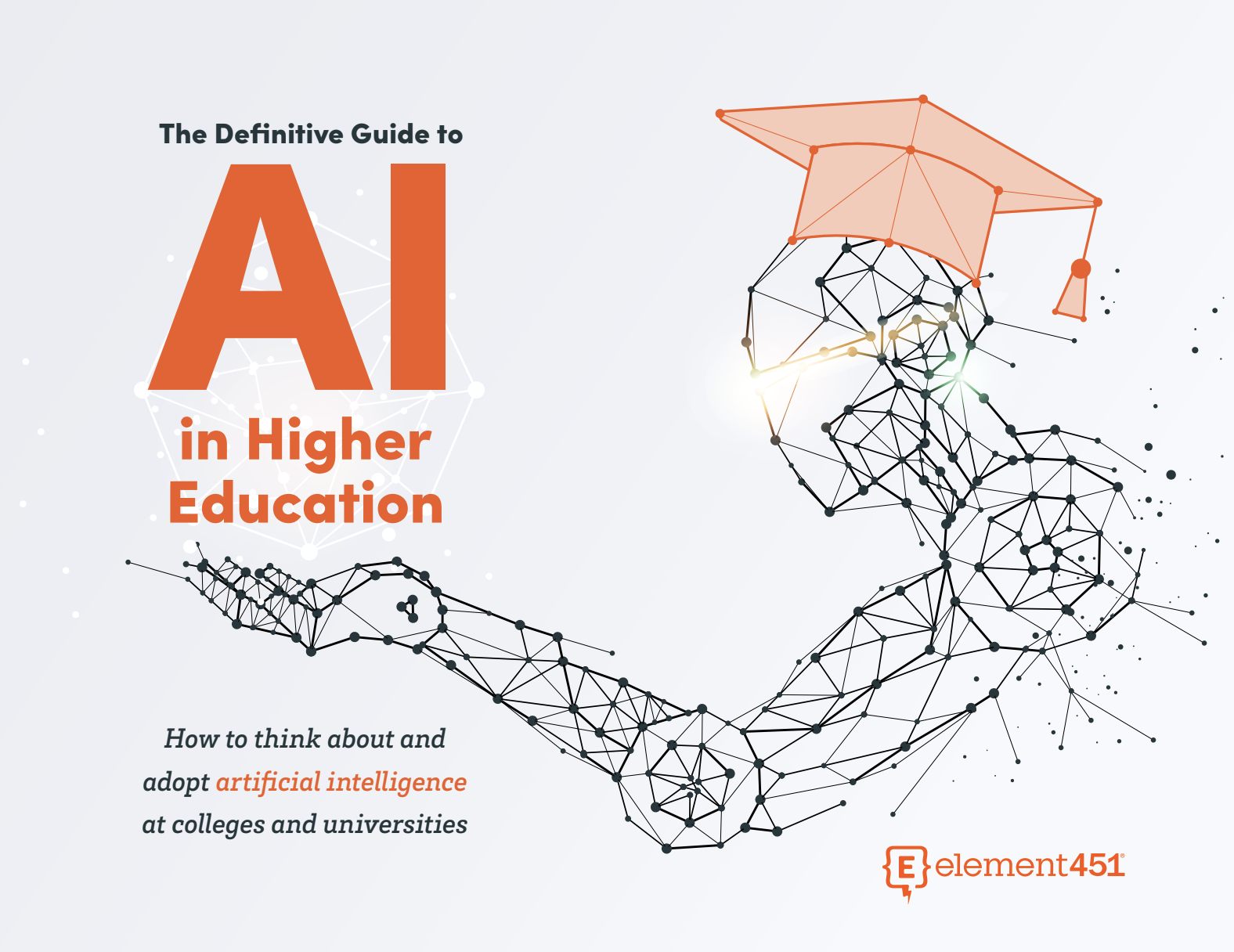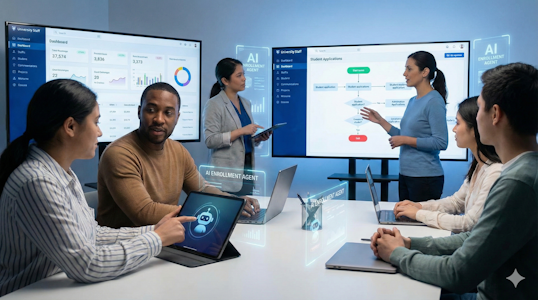From Chatbots to Colleagues: How AI Assistants Are Redefining Teamwork in Higher Education
by Ardis Kadiu · Updated Jan 15, 2025

Artificial intelligence in higher education is evolving beyond things like basic chatbots, stepping into roles that mirror human team members. The picture that’s emerging looks less like humans outsourcing tasks to AI. Instead, AI agents are joining teams as indispensable colleagues. They scour data — everything from email performance to application activity — recommend areas for operational and strategic improvements, and proactively contribute to team goals.
This shift is significant, raising questions about responsibilities and workplace dynamics. Yet the potential is clear: employees can focus on high-value activities and provide students with personalized attention when AI assistants are on the org chart too.
This article explores the most pressing concerns and opportunities higher education faces as it embraces a new way of working with AI.
A Day in the Life: Working with AI Assistants on Your Team
Imagine starting your day in admissions. An AI assistant has already sorted through overnight inquiries, flagged incomplete applications, and prioritized those needing immediate attention. By the time you log in, your tasks are clear, allowing you to focus on building connections with prospective students. This seamless handoff between human and AI team members exemplifies how these tools transform workflows and enhance efficiency.
Rather than replacing human staff, AI assistants function as digital colleagues. They take on repetitive or time-intensive tasks, freeing human employees for strategic work.
Now imagine the next wave of AI: agentic AI. Rather than flagging items for you, an AI agent would proactively send messages to students who need to complete their applications. They may even introduce them to their very own AI admissions assistant who would call them up and ask “How can I help you apply?”
To be sure, humans will continue to have a very important role in admissions (and all areas of enrollment and student success), but it will more often be doing the most human of activities. In this scenario, for example, if the student was experiencing family challenges that were getting in the way of them completing their application, the admissions counselor could have a video chat with the student, giving a personal face and voice to support them during a difficult time.
Optimizing Task Distribution Between AI and Human Teams
Effective AI implementation depends on clear task distribution. AI assistants contribute by automating data-heavy tasks such as sorting applications or analyzing large datasets, freeing human staff to focus on complex problem-solving and relationship-building activities. AI excels at data-driven tasks such as processing applications or analyzing engagement metrics. Meanwhile, human staff bring emotional intelligence, creativity, and nuanced problem-solving to the table.
For instance, in student success offices, AI can monitor engagement data to flag at-risk students. The current model might be that when an at-risk student is identified, a human advisor steps in to provide personalized support. But as schools become more confident and adept with AI, an AI agent would schedule a meeting for the student with a human or digital tutor.
We can start to see how the relationship between AI and humans will be symbiotic. It’ll be a hybrid model where AI and humans work together towards the same goal.
Knowing when to employ AI and when to involve a human will become new skills managers and leaders will need to hone.
Accountability and Oversight in AI-Driven Decision Making
As AI takes on more responsibilities, accountability becomes crucial. Higher education leaders must ensure human oversight in AI-driven processes, especially in high-stakes areas like financial aid.
Frameworks for accountability might include assigning staff to review AI-generated decisions or maintaining transparency in how AI algorithms operate. For example, Stanford University has developed guidelines for ethical AI use in education, emphasizing the importance of clear oversight and regular audits. A report from Stanford’s Human-Centered AI Institute emphasizes that ethical AI implementation requires rigorous oversight and clear policies. Institutions should also train staff to understand AI decision-making processes, fostering trust and reducing the risk of errors.
The Impact of AI on Workplace Culture and Team Morale
Introducing AI into the workplace has profound implications for team morale and culture, sparking both enthusiasm and concern. While many staff view AI as a valuable tool for reducing workload, some worry about potential job displacement or becoming overly dependent on technology.
To navigate these challenges, higher ed leaders should foster open communication about AI’s role and benefits. Highlighting success stories, such as reduced response times or improved student satisfaction, can alleviate concerns and foster confidence.
For instance, Forsyth Technical Community College implemented Element451’s AI-powered chatbot, which independently managed 79% of student inquiries, increasing answer rates from 53% to 85% between January 2023 and January 2024. This efficiency led to a 24% reduction in incoming calls and saved staff over 36,600 minutes, allowing them to focus on more strategic tasks.
Forsyth’s story, and similar ones from higher ed and beyond, demonstrate how AI complements rather than replaces human efforts.
Preparing Teams for AI Collaboration: Skills, Training, and Change Management
For AI to succeed, institutions must invest in training and change management. Staff need to develop skills to work alongside AI, from understanding data analytics to interpreting AI-generated insights.
Professional development programs are critical. For example, institutions might offer workshops on AI literacy or create pilot projects where staff and AI tools collaborate on specific tasks. Change management strategies should also address resistance by involving staff early in the adoption process and providing ongoing support. They should also reassure employees that AI is here to help them and their teams, not replace them.
Higher ed institutions that prioritize training and empathetically introduce AI will be better positioned to harness AI’s full potential. For more on what this preparation entails, listen to our Generation AI podcast where our CEO and founder Ardis Kadiu, and co-host JC Bonilla break down the journey from individual AI proficiency to organizational leadership.
Conclusion: Embracing the Future of AI in Higher Ed
Integrating AI into higher education is not just a technological shift; it’s a cultural transformation. By redefining roles, optimizing tasks, and fostering collaboration between humans and AI, institutions can address staffing challenges and ultimately turn a new page in the history of higher ed. Instead of overwhelmed employees struggling to complete their tasks, higher ed professionals will be steps ahead of their work.
As we move into the maturing era of agentic AI, higher ed leaders have an opportunity to lead this transformation thoughtfully. By aligning AI initiatives with institutional goals, transparently putting AI to work, and investing in staff development, they can create a workplace where humans and AI thrive together.

About Element451
Boost enrollment, improve engagement, and support students with an AI workforce built for higher ed. Element451 makes personalization scalable and success repeatable.
Categories
New Blog Posts

The Definitive Guide
AI in Higher Education
Bridge the gap between the latest tech advancements and your institution's success.
Useful Links
Related Articles

Talk With Us
Element451 is the only AI Workforce Platform for higher education. Our friendly experts are here to help you explore how Element451 can improve outcomes for your school.
Get a Demo








